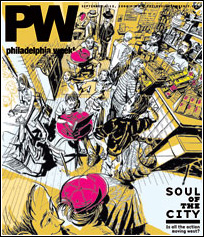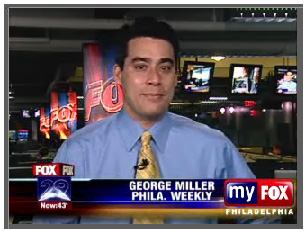Rhythm of the Street
Former Inky columnist Steve Lopez lands a film deal on an unlikely subject.
From the August 29, 2007 Philadelphia Weekly
Steve Lopez always made the Inquirer a good read.
He split in 1997 after 12 years of colorful narrative writing based on solid street-level reporting. As an Inquirer columnist, he spent more time in neighborhoods than at 400 N. Broad St. When he became an editor-at-large for Time Inc., he left a void at the Inquirer that's never been filled.
Lopez took his gritty style to the Los Angeles Times in 2001, and has documented, among other things, the less glamorous side of the City of Angels. He's now wrapping up a book about his relationship with a 56-year-old homeless L.A. street performer named Nathaniel Anthony Ayers.
Tentatively titled The Soloist, the book will be the basis of a DreamWorks SKG-produced movie scheduled to start filming in January. PW caught up with him last week by phone from his L.A. home.
How did you meet Nathaniel Ayers?
"I was just wandering around town, looking for a column. I was in downtown Los Angeles and I came across this guy at Pershing Square. He was playing a really beat-up violin that had carvings on it. What was striking was that the music sounded pretty good and it looked like he was living out of a cart."
When was this?
"Winter 2005. And then I would see him around now and then and listen to him play. It was a very cool thing. Downtown L.A. is a noisy, busy place, and what he was doing just looked so civilized. He was just so happy to be playing. He'd just drift off on the music and be so ecstatic."
Did you write about him then?
"No. Each time I talked to him the conversation lasted a little bit longer. He got more comfortable with me. I realized there was some mental health issue but I didn't know what. I noticed one day he was scrawling names on the sidewalk with a rock. I asked who the names were, and he said those were his classmates at Juilliard. I checked it out, and it was true. I also noticed his violin had only two strings - two were missing. He said, 'My whole goal in life is to figure out how to get the other two strings 'cause there's going to be so much more I can do on this thing when I get those two strings.'"
How long had he trained at Juilliard?
"He hadn't finished. He was in his third year when he had a breakdown. It was the fall of 1971. He was 20 years old. His life hasn't been the same since."
When did you first write about him?
"A few months after I first met him - April 2005. When I did, readers started donating instruments. I think I got five."
How did he react?
"He was shocked. In some ways he doesn't relate too well to our world. The idea that I'd written about him and that people had felt this connection to him was all very strange to him. His first reaction was, 'I can't accept anything I can't pay for.' I said, 'Well, they're in the brotherhood of musicians, and they want you to have them. It's a nice gesture, and if you want, I'll just keep them for you in case something goes wrong with the one you've got.' He kind of liked that idea, and then I had violins under my desk for a while. Then a cello was donated, and then another cello, and then a piano. Then I got an invite for him from the L.A. Philharmonic to go to a concert. He said he'd love to do it but there was no way because he was living on the streets. He hadn't bathed in quite a while and he didn't want to be a distraction. I proposed to the orchestra that we try a rehearsal. That way he wouldn't be a distraction."
This was to perform?
"No, just to see a concert. We went up, and he was thrilled - almost transformed - even as we approached Disney Hall. His mood changed. It was as if music is his medication. It was one of the things that drew me to the story - how art has the power to sustain and to inspire. He'd kept this with him through 35 years of struggles. And he was living on Skid Row at the time, which is home to a few thousand people - many of them mentally ill, many of them addicted."
Is there anything comparable to L.A.'s Skid Row in Philadelphia?
"No. It's kind of a third world, like a movie set. You turn a corner and see 50 people lighting crack pipes, people injecting heroin in front of you, prostitutes working out of the port-a-potties. There's complete lawlessness. At any given time there are a few thousand people just roaming a 10-square-block area that's beyond description."
Are there more characters in Los Angeles than Philly?
"Not per capita. It's just that we've got 16 million people here. It's teeming. We just have more of everything. I would bump into people like this back in Philly. I used to talk to Sister Mary Scullion at Project HOME, and she'd introduce me to people. Maybe this is sort of guilt because Sister Mary is one of my heroes. I remember writing a snide, obnoxious column about a guy who was sleeping on the street, and neighbors in the area wanted him out. I remember saying, 'Yeah, they have a right to feel that way.' I got a call from Sister Mary saying it's more complex than that. This guy is there because people with mental illnesses don't have the services and support that they need. This country has done a really poor job of this for decades and decades. I remember feeling so guilty being scolded by someone I so admired."
Jamie Foxx is lined up to play Ayers. Have you thought about who you want to portray you?
"I can tell you who they wanted. The first choice was Tom Hanks, but he had other commitments. I'm told that Steven Spielberg wanted him to do it."
Thinking about the movie in commercial terms, what's the ending of the story?
"Before I even agreed to talk to them, I wanted to make sure they understood there's not necessarily a happy ending here. We can't have a movie in which he ends up conducting the L.A. Philharmonic. His story has had an impact on public policy and public awareness and destigmatization of mental illness. He's a guy who's easy to root for. He's a charming, smart guy, struck down through no fault of his own. Through this chance encounter, he got a second chance to get back into music in ways that were unavailable to him."








